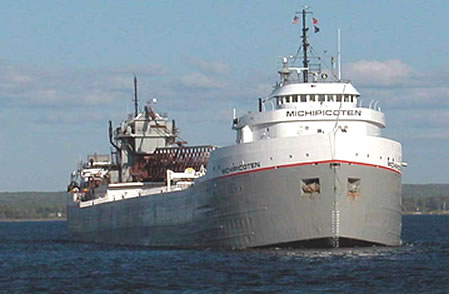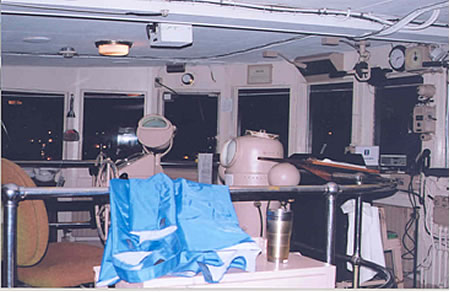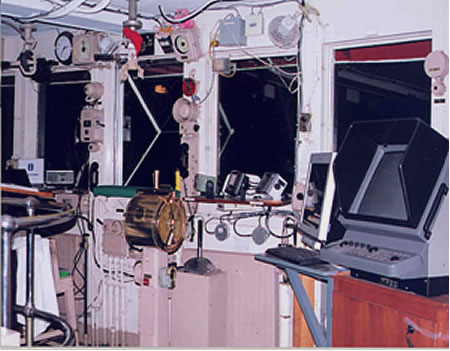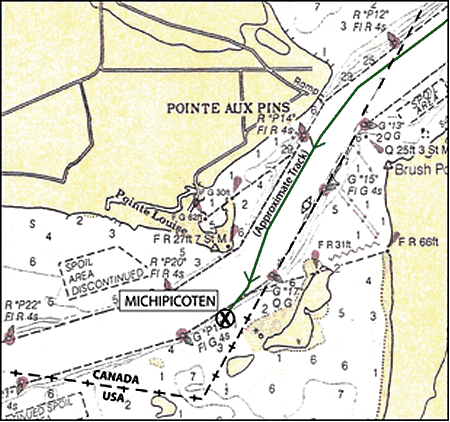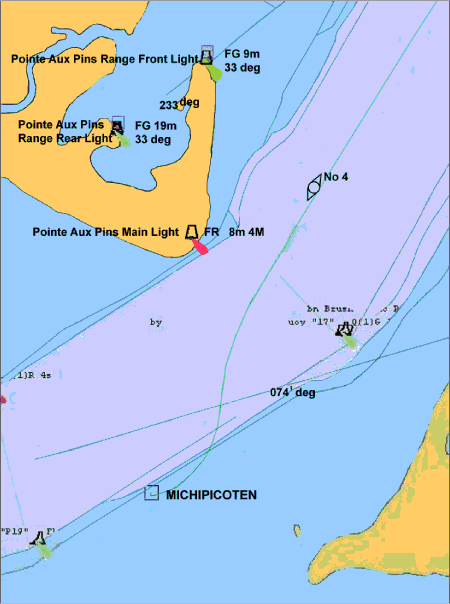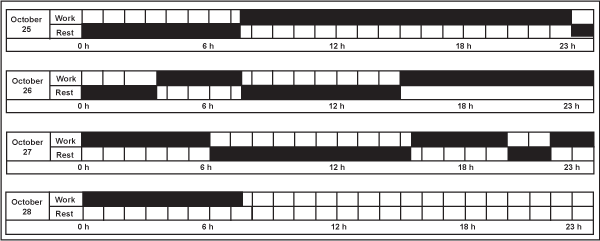Grounding
Bulk carrier Michipicoten
Brush Point Lighted Buoy G17
St. Mary's River, Ontario
The Transportation Safety Board of Canada (TSB) investigated this occurrence for the purpose of advancing transportation safety. It is not the function of the Board to assign fault or determine civil or criminal liability. This report is not created for use in the context of legal, disciplinary or other proceedings. See Ownership and use of content. Masculine pronouns and position titles may be used to signify all genders to comply with the Canadian Transportation Accident Investigation and Safety Board Act (S.C. 1989, c. 3).
Summary
On 28 October 2005 at 0733 eastern daylight time, while proceeding upbound in the St. Mary's River in Ontario with intermittent reduced visibility in fog patches, the bulk carrier Michipicoten ran aground near Brush Point Lighted Buoy G17. The vessel was refloated several hours later with no damage or injuries.
Ce rapport est également disponbible en français.
Factual information
Particulars of the vessel
| Name of vessel | Michipicoten |
|---|---|
| Official number | 825098 |
| Port of registry | Nanticoke, Ontario |
| Flag | Canada |
| Type | Self-unloading bulk carrier |
| Gross tonnageFootnote 1 | 15 366 |
| Length | 208.18 m |
| Draught | Forward: 4.34 m Aft: 6.35 m |
| Built | 1952, Bethlehem, Sparrow's Point, Maryland, United States |
| Propulsion | 5664 kW steam turbine |
| Cargo | None (ballast condition) |
| Crew | 18 |
| Registered owner(s) and manager(s) | Lower Lakes Towing, Ltd. |
Vessel description
The Michipicoten is typical of the split accommodation design of Great Lakes bulk carriers of the pre-1960s. The vessel's semi-circular wheelhouse is situated atop the forward accommodation deckhouse. Some of the wheelhouse windows at the forward conning station locations are of the vertically opening type.
The equipment in the wheelhouse includes two radars and an electronic chart system (ECS). The steering station is located on a raised platform in the middle of the wheelhouse providing the wheelsman with a good view ahead while in close proximity to the course and rudder angle indicators.
History of the voyage
The Michipicoten departedFootnote 2 the Algoma Steel docks at Sault Ste. Marie, Ontario, in ballast condition, upbound for the loading port at Marquette, Michigan, United States. During very high frequency (VHF) radiotelephone communication with Soo Traffic Control,Footnote 3 the master mistakenly identified his vessel as the Saginaw.
At the time of departure, the bridge crew consisted of the master and wheelsman.
About five minutes into the voyage, the chief officer (C/O) joined the bridge team for a short time and was then permitted by the master to go below to attend to other duties. Even though the master had intended to have the C/O return as soon as possible, the officer was otherwise occupied and did not return to the bridge - nor did the master insist on his return. With the wheelsman at the helm, the master continued to con the vessel, perform lookout duties, respond to VHF communications, and perform other tasks.
The master was conning the vessel mainly from the pilot's chair, which is forward and starboard of centre. From this position, he had to lean back and look over his right shoulder to see the ECS unit. The light level of the unit's screen was set to monochrome night display, which coloured the entire screen in red. The screen had also been covered with a red transparency to further lower the brightness of the screen. This reduced the clarity of information displayed, including the vessel's position icon.
The port 3 cm radar and the starboard 10 cm radar were operating and set to range scales of 1.5 and 3 miles, respectively. River conditions were calm with increasing periods of reduced visibility in fog patches. The vessel's fog signal was not sounding nor was an additional lookout posted. None of the Michipicoten's wheelhouse windows were opened to improve the view ahead and increase the chance of hearing any signals from other vessels. At 0701, the Michipicoten increased speed to approximately 8.5 knots and left the Canadian channel. While communicating with Soo Traffic Control, upon entering the upper St. Mary's River, the master again misidentified his vessel as the Saginaw. At this time, the Michipicoten was approximately one-half to three-quarters of a mile ahead of the tug Dorothy Ann and barge Pathfinder. Both vessels were upbound and had just departed McArthur Lock. There was VHF communication between the vessels regarding the possibility of the tug and barge overtaking the Michipicoten. Near the line between Brush Point Buoy G13 and Pointe aux Pins, the Michipicoten altered course to port to follow the recommended main channel course of 210° true (T) in the direction of Pointe Louise. The next course alteration to 238° T (starboard course alteration) would take place at the line between Brush Point Buoy G17 and Pointe Louise. At approximately 0723, while approaching the next course alteration, fog had obscured the channel's easterly limit on the vessel's port side, and the master could not see the next forward set of ranges. While attempting to see buoys on the channel's easterly limit, he was in communication with Soo Traffic Control.
At this time, he reportedly gave the wheelsman the order "20 degrees starboard" with the intention of settling on the new course of 238° T. The wheelsman, however, heard the order as "20 degrees port." As a result, he turned the wheel until the rudder angle indicated 20 degrees to port. He then repeated the order, although the master has no recollection of the order being repeated. As soon as the helm order was given, the master turned his attention toward communicating with the Dorothy Ann about the possibility of being overtaken. As the Michipicoten began turning to port, the master did not observe the movement of the rudder angle indicator from his forward seated position. At approximately 0725, the master saw the image of what appeared to be the ranges at Brush Point reflected in one of the wheelhouse windows. He interpreted this image to mean that the vessel was turning to starboard. At 0727, the Michipicoten was continuing to turn to port. Meanwhile, the wheelsman was able to see the electronic chart display from the steering position. Although untrained in its use, he deduced that the Michipicoten was southbound, out of the channel, and informed the master that the last manoeuvring instruction to port may have been a mistake. The master immediately ordered "hard to starboard." The Michipicoten reduced its turning rate to port and started turning to starboard. However, the vessel was too close to the channel's southeasterly side and at 0733 the vessel grounded in soft mud, just inside the Canadian border between Brush Point buoys G17 and P19 in position 46°27′34″ N, 084°28′23″ W (see Figure 2). Following the grounding, all tanks were sounded, and no ingress of water or apparent damage was found. In its grounded position, the vessel did not obstruct either upbound or downbound traffic. The vessel remained grounded until tug assistance was provided several hours later.
Electronic Chart System
The ECS delivers an automatic and continuous display of present position, heading, course, and speed of the vessel. Since the ECS automatically displays and continually assesses chart and navigation-related information, a mariner can concentrate on navigating the vessel. Although the ECS does not meet International Maritime Organization (IMO) performance standards for electronic chart display and information systems (ECDIS), it has nonetheless gained widespread acceptance and considerable commercial use because it offers mariners an efficient source of navigational information. A feature within the ECS software provides the end user with light-level controls, allowing the display to be illuminated for various ambient light conditions. The ECS in use on the Michipicoten has three default settings: default day, default dusk, and default night. The display colour palette can also be inverted to produce a negative image of the previous screen. Additionally, a "monochrome" option allows the entire image to be shown in red, green or blue. At the time of the occurrence, the display was set to the default night mode with the red monochrome option. Additionally, a red transparency had been placed over the screen to further reduce brightness. Although navigation details were thus harder to discern, this did not prevent the wheelsman from using the chart display as a cue to warn the master that the vessel had left the intended track.
Personnel
Master
The master held a master's certificate, Canadian inland waters, since 18 May 1999 and had been employed by Lower Lakes Towing, Ltd. since 2003. He was given alternating positions of mate and master for the vessels Michipicoten and Saginaw until he became familiar with the piloting and handling characteristics of each vessel. Each of these work periods lasted an average of several months. Previously, he had worked several years for Seaway Marine Transport as a second officer and C/O.
Wheelsman
The wheelsman received a bridge watch certificateFootnote 4 in September . He was new to the profession and had a total of three months' experience in the position. During that time, he had made approximately 11 trips through the area.
Master's work/rest periods
The results of calculations used in determining whether a person's 24-hour and 48-hour work/rest schedule depend on the specific hour chosen as to when the period under review begins and ends. In this instance, calculations began at 0730 on October 25 and ended at 0730 on October 28. The master piloted the bulk carrier Saginaw for 15.5 consecutive hours from 0730 until 2300 on October 25. Commencing at 1500 the following day, he piloted the vessel single-handedly for another 15 consecutive hours until 0600 on October 27. Finally, commencing at 2200, he piloted the Saginaw for seven and a half hours until it arrived at the Algoma Steel docks, Sault Ste. Marie, at 0520 on October 28. Minutes later, he boarded the Michipicoten at about 0545 and piloted it until it grounded less than two hours later at 0730.Footnote 5 The master rested for a total of four and a half continuous hours during the 24-hour period beginning at 0730 on October 25. Later on October 26, he rested for seven and a half continuous hours and, on October 27, he rested for nine and a half continuous hours.Footnote 6 He obtained a total of 13.5 hours of rest during the 48-hour period commencing at 0730, October 25, and the same time on October 27. During a second 48-hour period between 0730, October 26, and 0730, October 28, he obtained a total of 19 hours.Footnote 7 Between rest periods on October 26, the master worked a relatively short period of four hours between 0330 and 0730. Similarly, he worked four and half hours between rest periods on October 27.Footnote 8
Bridge Resource Management
Bridge Resource Management (BRM) is the effective management and utilization of all resources available to the bridge team to ensure the safe completion of the vessel's voyage. In this instance, the master was conning and navigating the vessel through restricted waterways and in reduced visibility, as well as attending to all VHF communications, log book entries, lookout, and other watchkeeping duties. Elements of BRM, including passage planning, consideration of bridge crewing levels,Footnote 9 and the effective use of radar and ECS, were not practiced.
Weather
There were conflicting accounts as to visibility. Some information indicates that there were sections of zero visibility and intermittent reduced visibility for approximately 30 minutes before the grounding. Other information indicates that visibility was relatively clear until 5 or 10 minutes before the grounding. Environment Canada weather data for the general area, including the upper St. Mary's River, indicate that, from 0500 until almost 0800, there were increasing periods of reduced visibility with little to no wind.Footnote 10 The area from Sault Ste. Marie to Whitefish Bay was affected by fog and freezing fog (sublimation).
Analysis
Bridge Resource Management
Verbal exchange between the wheelsman and the master was misinterpreted by both. With the vessel moving in the wrong direction, the available instruments such as the rudder angle indicator, radar, and ECS (which may have helped detect the wrong course) were not consulted. It was not until the wheelsman volunteered that he thought that the vessel was on the wrong heading that the master ordered a course correction, which nonetheless failed to prevent the grounding.
Master's work/rest periods
In Canada, there exists a set of well-established regulatory requirementsFootnote 11 serving as safety guidelines to help masters and officers avoid the risks associated with fatigue. Nonetheless, these were not incorporated in the company's written procedures. In this occurrence, some features of the master's work/rest schedule fall short of the minimum acceptable levels identified in the requirements. For example, a minimum of six consecutive hours of rest in a 24-hour periodFootnote 12 is considered necessary, whereas the master had only four and a half hours of rest between 2300 on October 25 and 0330 the next morning. In addition, a total of at least 16 hours of rest during any 48-hour period is a minimum requirement and the master had rested for a total of 13.5 hours in one of the two 48-hour periods under review.Footnote 13 On 25 October , the master was on duty for 15.5 consecutive hours and overnight between 26 and 27 October, he worked another 15 consecutive hours. At the time of the accident, he had been on duty for nine consecutive hours. Although he had 19 hours of rest in the 48 hours immediately before the occurrence, it is unclear how many of those hours were spent in sleep. Taking into account the master's 15.5-, 15-, and 9-hour periods over three days and one instance of having rested for fewer hours than the minimum set out in the established guidelines, this schedule may have predisposed him to fatigue-related performance issues. It is critical that crew, officers, and masters occupying safety-sensitive positions have adequate rest periods between work shifts as required by safety regulations. Otherwise, resulting fatigue could degrade performance and adversely affect safety.
Findings
Findings as to causes and contributing factors
- The grounding occurred when the vessel crossed to the channel's southeasterly limit.
- The vessel had turned to the south when a miscommunication occurred between the bridge team, resulting in an incorrect helm application.
- The incorrect heading was not detected in a timely manner because the rudder angle indicator was not sighted by the master and navigation instruments such as radar and electronic chart system (ECS) were not used to their full potential.
- Despite the critical nature of the navigation at hand, the master was the sole officer carrying out all navigation and communication duties.
- The master's work/rest schedule for October 25 and 26 did not adhere to well-established regulatory requirements.
Findings as to risk
- The regulatory requirements to help ensure masters and officers have enough rest were not incorporated in the company's written procedures.
Other findings
- The use of the monochrome option for the ECS in conjunction with the night display presentation and the red transparency placed over the screen resulted in a reduction of chart, course, and vessel-position details.
- The master's schedule may have predisposed him to fatigue-related performance issues.
Safety action
Action taken
Transport Canada
Transport Canada Marine Safety Ontario Region is implementing a monitoring programme for 2008. Elements of this programme, that will be applicable to all domestic vessels on a random sampling, will include the following:
- verification of crewing levels as per the Safe Manning Certificate;
- checking of master's log of crew members' hours of work and hours of rest;
- vetting all crewing certificates including Marine Emergency Duties for non-certificated crew; and
- checking the validity of the crew members' medical certificates.
This report concludes the Transportation Safety Board's investigation into this occurrence. Consequently, the Board authorized the release of this report on .
